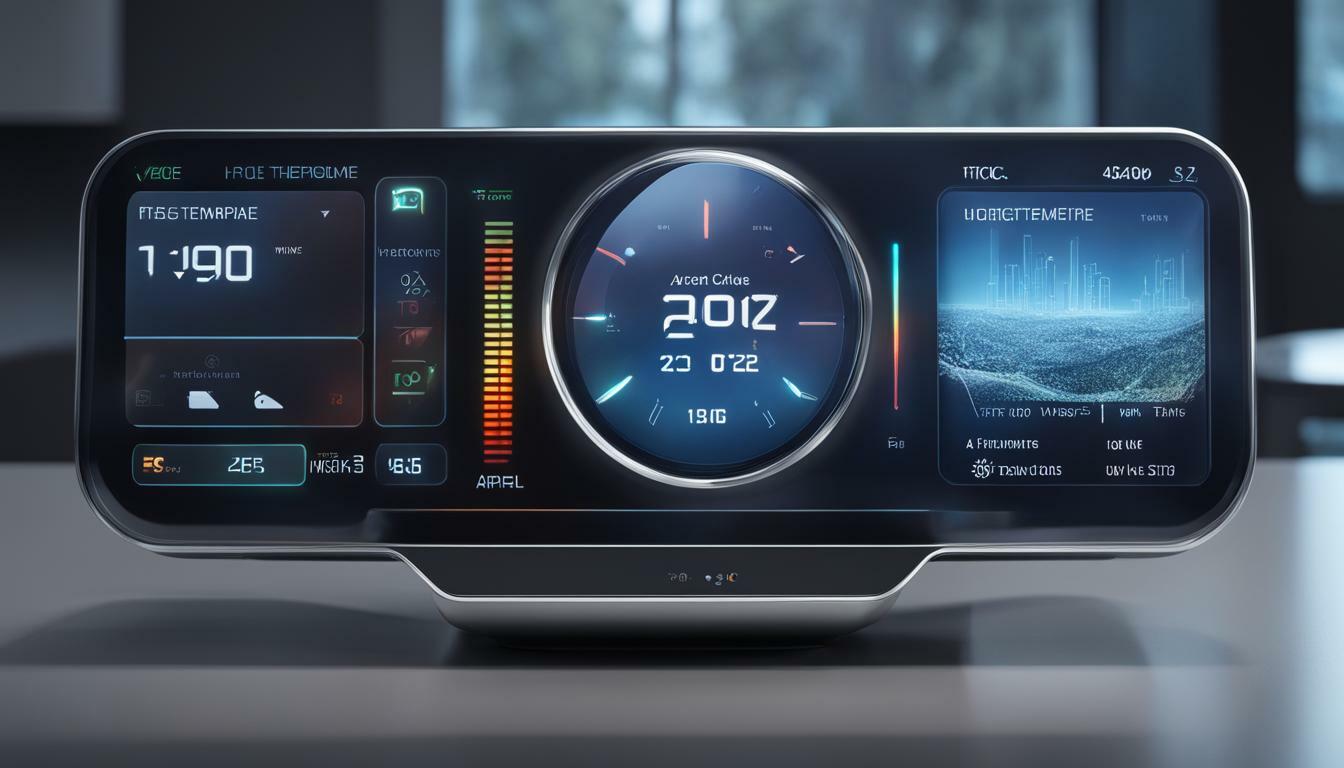Smart thermostats, powered by advanced technology, provide a convenient and energy-efficient solution for managing your home’s temperature. These innovative devices utilize Wi-Fi connectivity to communicate with an app on your phone or through a touchscreen display. With the ability to schedule heating and cooling routines, adjust the temperature remotely, and connect with other smart devices, smart thermostats offer a range of features that enhance comfort and convenience in your home.
Key Takeaways:
- Smart thermostats use Wi-Fi to connect with an app on your phone or through a touchscreen display.
- They allow you to schedule heating and cooling routines and adjust the temperature remotely.
- Smart thermostats can learn your preferences and automatically adjust the temperature accordingly.
- They can be integrated with voice assistants and track energy use to help you save money.
- Installation may require electrical wiring changes, and compatibility with your phone and other smart devices is important.
Connecting with Your Smart Home – Exploring Smart Thermostat Features
Smart thermostats offer a range of features that go beyond traditional programmable thermostats, allowing for seamless integration with your smart home ecosystem. With their advanced technology, these devices provide greater control and convenience in managing your home’s temperature.
One of the key features of smart thermostats is remote temperature control. Through a Wi-Fi connection, you can adjust the temperature of your home from anywhere using your smartphone. Imagine being able to turn up the heat before you arrive home on a cold winter day or lower it from your bed on a hot summer night. It’s all possible with the touch of a button.
Additionally, smart thermostats can integrate with other smart devices in your home, such as voice assistants like Amazon Echo or Google Home. This enables you to control your thermostat using voice commands, making it even more convenient to manage your home’s temperature. Simply say, “Alexa, set the thermostat to 72 degrees,” and your smart home will respond accordingly.
Furthermore, smart thermostats excel in optimizing HVAC systems to save energy and reduce costs. By learning your heating and cooling preferences over time, these devices can automatically adjust the temperature based on your behavior and schedule. This not only enhances comfort but also leads to improved energy efficiency. You can track your energy usage and make data-driven decisions to further optimize your system, resulting in significant savings on your electricity bill.
| Smart Thermostat Features | Benefits |
|---|---|
| Remote Temperature Control | Convenience and flexibility in managing your home’s temperature from anywhere. |
| Smart Home Integration | Seamless connection with voice assistants and other smart devices for easy control. |
| HVAC System Optimization | Improved energy efficiency, cost savings, and data-driven decision-making. |
In summary, smart thermostats offer a wide range of features that enhance your home’s comfort, convenience, and energy efficiency. With remote temperature control, smart home integration, and HVAC system optimization, these devices truly revolutionize the way we manage our heating and cooling systems. By choosing a reliable smart thermostat brand like Google Nest, Honeywell Home, or Ecobee, you can take full advantage of these innovative technologies and enjoy a smarter, more efficient home.
Learning and Adapting – The Intelligent Capabilities of Smart Thermostats
Thanks to advanced algorithms and machine learning, smart thermostats can adapt to your lifestyle, ensuring optimal comfort while minimizing energy waste. These intelligent devices utilize data from various sensors and inputs to learn your heating and cooling preferences over time. This means that the more you use your smart thermostat, the better it becomes at understanding and anticipating your needs.
Smart thermostats use a combination of historical data, user inputs, and external factors to make temperature adjustments automatically. For example, if you typically lower the temperature at night, your smart thermostat will learn this pattern and adjust accordingly. It can also take into account factors such as weather conditions and occupancy patterns to optimize temperature settings throughout the day.
But learning goes beyond simply adjusting the temperature based on set patterns. Smart thermostats can also adapt to changes in your schedule. If your routine suddenly changes, such as when you go on vacation or start working from home, the thermostat will learn this new pattern and make appropriate adjustments. This means you can enjoy the perfect temperature without having to constantly manually adjust the thermostat.
Key Benefits of Learning Capabilities
- Energy Efficiency: Smart thermostats can significantly reduce energy waste by automatically adjusting temperatures based on your needs. This can lead to substantial savings on your electricity bill while minimizing your carbon footprint.
- Customized Comfort: With learning capabilities, your smart thermostat can provide personalized comfort tailored to your preferences and schedule. No more waking up to a chilly room or coming home to an overly warm house.
- Convenience and Peace of Mind: By adapting to your lifestyle, smart thermostats eliminate the need for constant manual adjustments. You can relax knowing that your home will always be at the perfect temperature.
Overall, the learning and adapting capabilities of smart thermostats empower homeowners to achieve a perfect balance between comfort and energy efficiency. With advanced algorithms and machine learning, these devices make it easier than ever to create a comfortable home environment while minimizing energy waste.
| Smart Thermostat Brands | Key Features |
|---|---|
| Google Nest | Geofencing, motion sensors, compatibility with voice assistants |
| Honeywell Home | Energy usage tracking, customizable scheduling, compatibility with smart home devices |
| Ecobee | Room sensors, remote temperature control, integration with popular smart home platforms |
Installation and Optimization – Making the Most of Your Smart Thermostat
Installing a smart thermostat involves careful consideration of compatibility and potential electrical modifications to ensure a seamless integration into your home’s heating and cooling system. To start, check if your current thermostat is compatible with smart thermostat technology. Some older systems may require additional wiring or a separate C-wire for power, while others may not be compatible at all. Consulting a professional electrician or HVAC technician can help you determine the necessary modifications for successful installation.
Once you have ensured compatibility, it’s time to choose the right smart thermostat for your needs. Consider factors such as the device’s ease of use, range of features, and compatibility with other smart devices in your home. Popular smart thermostat brands like Google Nest, Honeywell Home, and Ecobee offer a variety of models to choose from, each with its own unique features and capabilities.
| Key Considerations for Smart Thermostat Installation: | Benefits: |
|---|---|
| Compatibility with your current heating and cooling system | Seamless integration and optimal performance |
| Potential electrical modifications | Safe and efficient installation |
| Choosing a compatible smart thermostat | Convenience and enhanced control over your HVAC system |
After installation, optimizing your smart thermostat’s performance is crucial for maximizing energy savings and comfort. Start by familiarizing yourself with the device’s user manual and learning about its various features. Take advantage of the app or touchscreen display to set up custom schedules and adjust temperature settings to suit your preferences.
Monitoring your smart thermostat’s performance is equally important. Keep a close eye on key metrics such as temperature, energy usage, schedule effectiveness, and connectivity. This data can help you identify patterns, make data-driven decisions, and fine-tune your settings for optimal efficiency. Regularly updating the firmware and ensuring a stable Wi-Fi connection can also contribute to better performance.
Summary
Installing a smart thermostat involves considering compatibility and potential electrical modifications for seamless integration. Choose a smart thermostat that suits your needs and is compatible with your existing heating and cooling system. Optimize its performance by familiarizing yourself with its features, monitoring key metrics, and making data-driven decisions. By embracing smart thermostat technology, you can enjoy improved comfort, energy savings, and the convenience of controlling your home’s temperature remotely.
Conclusion – Embrace the Benefits of Smart Thermostat Technology
Embracing smart thermostat technology unlocks a range of benefits, from increased comfort and convenience to significant energy savings. These innovative devices work by using Wi-Fi to connect with an app on your phone or through a user-friendly touchscreen display. With smart thermostats, you have the power to schedule personalized heating and cooling routines, adjust the temperature remotely, and seamlessly connect with other smart devices in your home.
One of the standout features of smart thermostats is their ability to learn your heating and cooling preferences over time. By analyzing data and using advanced algorithms, they can automatically adjust the temperature accordingly, ensuring optimal comfort while maximizing energy efficiency. You can also integrate smart thermostats with voice assistants, allowing you to easily control the temperature using simple voice commands.
Installing a smart thermostat may require electrical wiring changes, but it is a worthwhile investment. When choosing a smart thermostat, it’s essential to select a device that is compatible with your phone and other smart devices, ensuring a seamless and interconnected experience. By monitoring and optimizing the performance of your smart thermostat, you can achieve significant energy savings and make data-driven decisions for improved efficiency.
Popular smart thermostat brands that offer reliable and innovative solutions include Google Nest, Honeywell Home, and Ecobee. These brands offer a range of models with various features to suit different needs. Some smart thermostats come with geofencing capabilities, which adjust the temperature based on your location, ensuring comfort when you arrive home. Others incorporate motion sensors, which detect activity in a room and adjust the temperature accordingly, saving energy when no one is present. Additionally, many models have self-learning capabilities, continuously adapting to your preferences and schedule to optimize energy usage.
FAQ
How does a smart thermostat work?
Smart thermostats use Wi-Fi to connect with an app on your phone or through a touchscreen display. They allow you to schedule heating and cooling routines, adjust the temperature remotely, and connect with other smart devices. Some models can learn your heating and cooling preferences and automatically adjust the temperature accordingly.
What are the key features of a smart thermostat?
Smart thermostats offer various features such as remote temperature control, integration with voice assistants, and the ability to optimize your HVAC system. They can also track energy usage, helping you save money on your electricity bill.
How do I install a smart thermostat?
Installation may require electrical wiring changes, so it’s important to follow the manufacturer’s instructions or hire a professional. Additionally, it’s essential to choose a smart thermostat that is compatible with your phone and other smart devices.
What should I monitor to optimize my smart thermostat’s performance?
To optimize your smart thermostat’s performance, you should track temperature, energy usage, schedule effectiveness, and connectivity. This data-driven approach can lead to energy savings, improved comfort, and better decision-making.
What additional features do smart thermostats offer?
Smart thermostats may offer features such as geofencing, motion sensors, and self-learning capabilities to enhance convenience and energy efficiency. Popular smart thermostat brands include Google Nest, Honeywell Home, and Ecobee.




